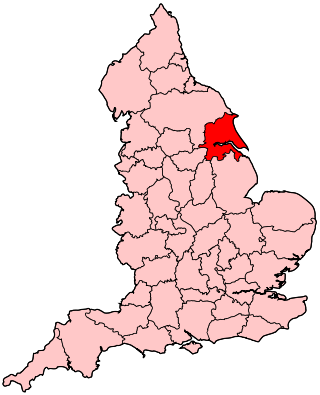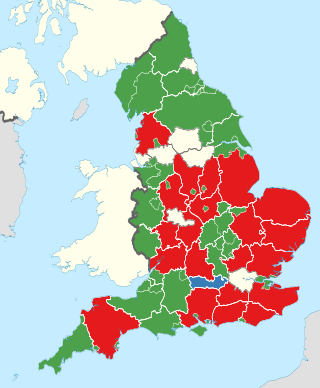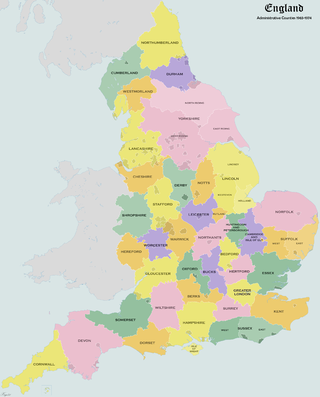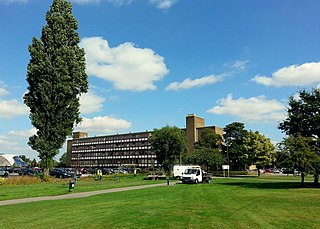
North Lincolnshire is a unitary authority area with borough status in Lincolnshire, England. At the 2011 Census, it had a population of 167,446. The administrative centre and largest settlement is Scunthorpe, and the borough also includes the towns of Brigg, Broughton, Haxey, Crowle, Epworth, Bottesford, Winterton, Kirton in Lindsey and Barton-upon-Humber. North Lincolnshire is part of the Yorkshire and the Humber region.

Scunthorpe is an industrial town in the North Lincolnshire district of Lincolnshire, England. It is Lincolnshire's third most populous settlement, after Lincoln and Grimsby, with a population of 81,286 in 2021.

Humberside was a non-metropolitan and ceremonial county in Northern England from 1 April 1974 until 1 April 1996. It was composed of land from either side of the Humber Estuary, created from portions of the East Riding of Yorkshire, West Riding of Yorkshire, and the northern part of Lindsey, Lincolnshire. The county council's headquarters was County Hall at Beverley, inherited from East Riding County Council. Its largest settlement and only city was Kingston upon Hull. Other notable towns included Goole, Beverley, Scunthorpe, Grimsby, Cleethorpes and Bridlington. The county stretched from Wold Newton at its northern tip to a different Wold Newton at its southernmost point.

The counties of England are divisions of England. Counties have been used as administrative areas in England since Anglo-Saxon times. There are two main legal definitions of the counties in modern usage: the 84 counties for the purposes of local government, and the 48 counties for the purposes of lieutenancy, also termed the ceremonial counties.

Ceremonial counties, formally known as counties for the purposes of the lieutenancies, are areas of England to which lord-lieutenants are appointed. They are one of the two main legal definitions of the counties of England in modern usage, the other being the counties for the purposes of local government legislation. A lord-lieutenant is the monarch's representative in an area. Shrieval counties have the same boundaries and serve a similar purpose, being the areas to which high sheriffs are appointed. High sheriffs are the monarch's judicial representative in an area.

The Parts of Lindsey are a traditional division of Lincolnshire, England, covering the northern part of the county. The Isle of Axholme, which is on the west side of the River Trent, has normally formed part of it. The district's name originated from the Kingdom of Lindsey of Anglo-Saxon times, whose territories were merged with that of Stamford to form Lincolnshire.

Glanford was, from 1974 to 1996, a local government district with borough status in the non-metropolitan county of Humberside, England.

The Local Government Act 1972 is an act of the Parliament of the United Kingdom that reformed local government in England and Wales on 1 April 1974. It was one of the most significant Acts of Parliament to be passed by the Heath Government of 1970–74.

A non-metropolitan county, or colloquially, shire county, is a subdivision of England used for local government.
The history of local government in Yorkshire is unique and complex. Yorkshire is the largest historic English county and consists of a diverse mix of urban and rural development with a heritage in agriculture, manufacturing, and mining. After a long period with little change, it has been subject to a number of reforms of local government structures in modern times, some of which were controversial. The most significant of these were the Local Government Act 1972, the 1990s UK local government reform, and the Localism Act 2011. The historic area currently corresponds to several counties and districts and is mostly contained within the Yorkshire and the Humber region.

Administrative counties were subnational divisions of England used for local government from 1889 to 1974. They were created by the Local Government Act 1888, which established an elected county council for each area. Some geographically large historic counties were divided into several administrative counties, each with its own county council. The administrative counties operated until 1974, when they were replaced by a system of metropolitan and non-metropolitan counties under the Local Government Act 1972.
The Local Government Boundary Commission for England (LGBCE) was the statutory body established under the Local Government Act 1972 to settle the boundaries, names and electoral arrangements of the non-metropolitan districts which came into existence in 1974, and for their periodic review. The stated purpose of the LGBCE was to ensure "that the whole system does not get frozen into the form which has been adopted as appropriate in the 1970s". In the event it made no major changes and was replaced in 1992 by the Local Government Commission for England.

North East Lincolnshire Council is the local authority of North East Lincolnshire. It is a unitary authority, having the powers of a county council and district council combined. It was established on 1 April 1996 on the abolition of Humberside County Council, Great Grimsby Borough Council and Cleethorpes Borough Council. The council provides a full range of local government services including Council Tax billing, libraries, social services, processing planning applications, waste collection and disposal, and it is a local education authority.

North Lincolnshire Council is the local authority of North Lincolnshire, England. It is a unitary authority, having the powers of a county council and district council combined. It provides a full range of local government services including Council Tax billing, libraries, social services, town planning, and waste collection and disposal. It is also a local education authority. The council is based in Scunthorpe.

Barton upon Humber was an Urban District in Parts of Lindsey, Lincolnshire, England from 1894 to 1974. It was created under the Local Government Act 1894.

Brigg was an Urban District in Parts of Lindsey, Lincolnshire, England from 1894 to 1974. It was created under the Local Government Act 1894.

Cleethorpes was an Urban District and Municipal Borough in Parts of Lindsey, Lincolnshire, England from 1894 to 1974.
Scunthorpe was a non-metropolitan district in Humberside, England. It was abolished on 1 April 1996 and replaced by North Lincolnshire.

Scunthorpe Civic Centre, also known as Pittwood House, is a municipal building in Ashby Road in Scunthorpe, a town in Lincolnshire in England. The building served as the headquarters of Scunthorpe Municipal Borough Council and later of North Lincolnshire Council, but is now used as a university campus. It is a Grade II listed building.
















